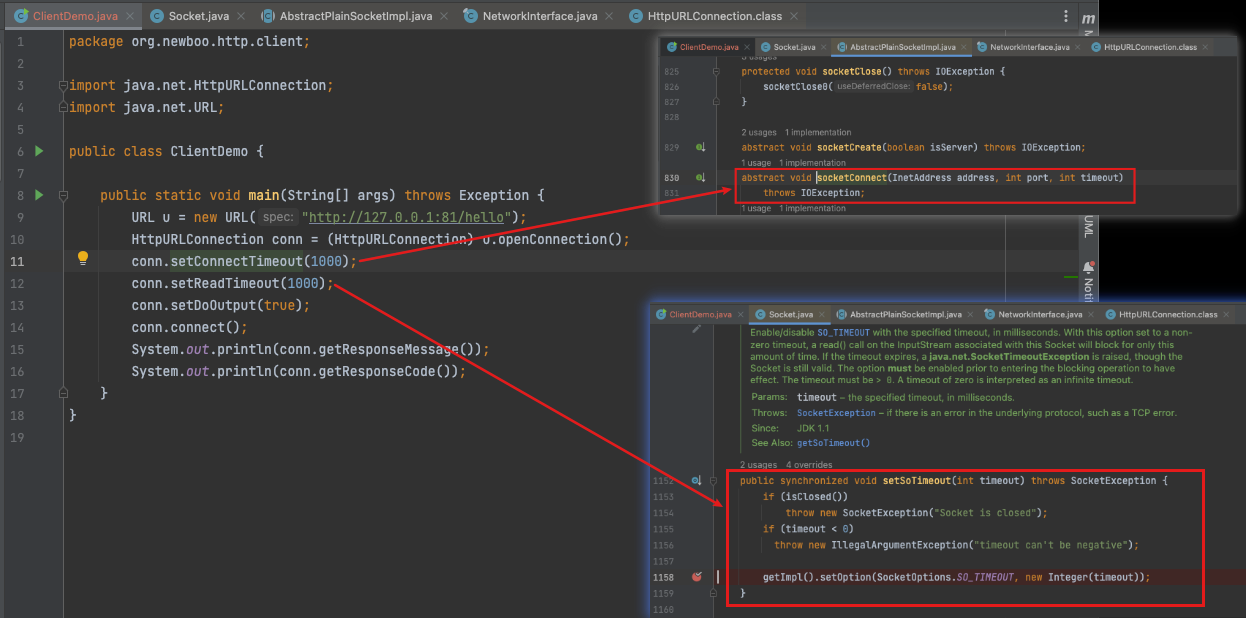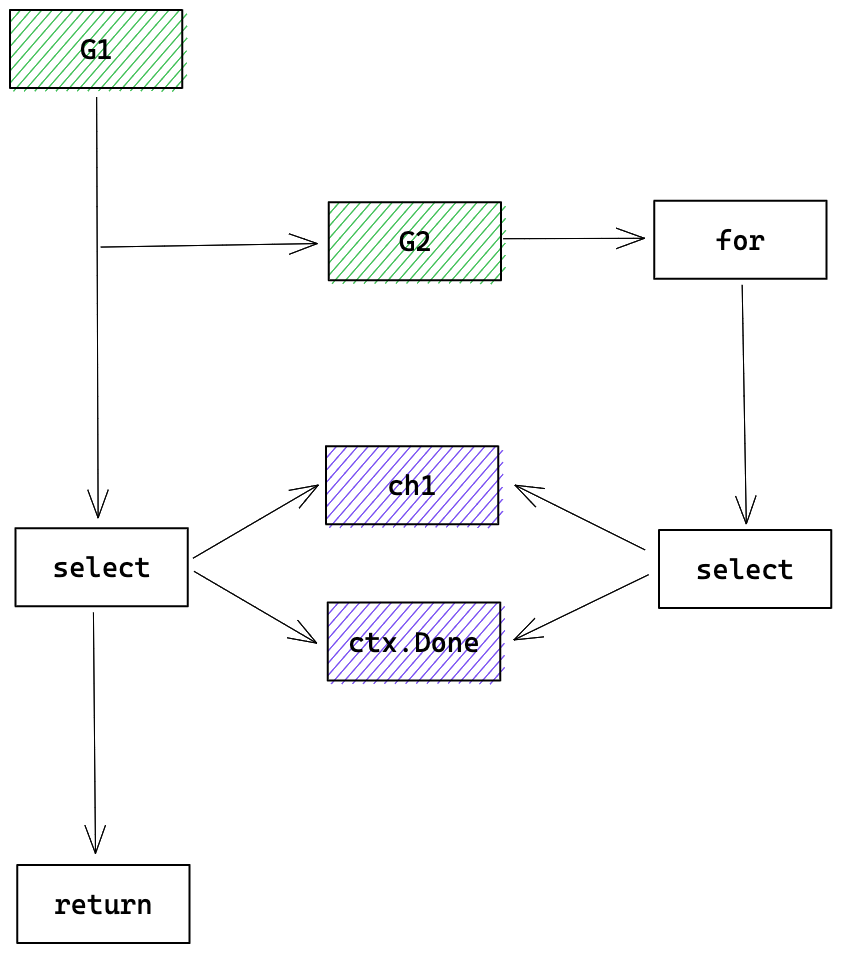有趣的 Go HttpClient 超時機制
hello,大家好呀,我是既寫 Java 又寫 Go 的小樓,在寫 Go 的過程中經常對比這兩種語言的特性,踩了不少坑,也發現了不少有意思的地方,今天就來聊聊 Go 自帶的 HttpClient 的超時機制。
Java HttpClient 超時底層原理
在介紹 Go 的 HttpClient 超時機制之前,我們先看看 Java 是如何實現超時的。
寫一個 Java 原生的 HttpClient,設定連線超時、讀取超時時間分別對應到底層的方法分別是:

再追溯到 JVM 原始碼,發現是對系統呼叫的封裝,其實不光是 Java,大部分的程式語言都藉助了作業系統提供的超時能力。
然而 Go 的 HttpClient 卻提供了另一種超時機制,挺有意思,我們來盤一盤。但在開始之前,我們先了解一下 Go 的 Context。
Go Context 簡介
Context 是什麼?
根據 Go 原始碼的註釋:
// A Context carries a deadline, a cancellation signal, and other values across
// API boundaries.
// Context's methods may be called by multiple goroutines simultaneously.
Context 簡單來說是一個可以攜帶超時時間、取消訊號和其他資料的介面,Context 的方法會被多個協程同時呼叫。
Context 有點類似 Java 的ThreadLocal,可以線上程中傳遞資料,但又不完全相同,它是顯示傳遞,ThreadLocal 是隱式傳遞,除了傳遞資料之外,Context 還能攜帶超時時間、取消訊號。
Context 只是定義了介面,具體的實現在 Go 中提供了幾個:
- Background :空的實現,啥也沒做
- TODO:還不知道用什麼 Context,先用 TODO 代替,也是啥也沒做的空 Context
- cancelCtx:可以取消的 Context
- timerCtx:主動超時的 Context
針對 Context 的三個特性,可以通過 Go 提供的 Context 實現以及原始碼中的例子來進一步瞭解下。
Context 三個特性例子
這部分的例子來源於 Go 的原始碼,位於 src/context/example_test.go
攜帶資料
使用 context.WithValue 來攜帶,使用 Value 來取值,原始碼中的例子如下:
// 來自 src/context/example_test.go
func ExampleWithValue() {
type favContextKey string
f := func(ctx context.Context, k favContextKey) {
if v := ctx.Value(k); v != nil {
fmt.Println("found value:", v)
return
}
fmt.Println("key not found:", k)
}
k := favContextKey("language")
ctx := context.WithValue(context.Background(), k, "Go")
f(ctx, k)
f(ctx, favContextKey("color"))
// Output:
// found value: Go
// key not found: color
}
取消
先起一個協程執行一個死迴圈,不停地往 channel 中寫資料,同時監聽 ctx.Done() 的事件
// 來自 src/context/example_test.go
gen := func(ctx context.Context) <-chan int {
dst := make(chan int)
n := 1
go func() {
for {
select {
case <-ctx.Done():
return // returning not to leak the goroutine
case dst <- n:
n++
}
}
}()
return dst
}
然後通過 context.WithCancel 生成一個可取消的 Context,傳入 gen 方法,直到 gen 返回 5 時,呼叫 cancel 取消 gen 方法的執行。
// 來自 src/context/example_test.go
ctx, cancel := context.WithCancel(context.Background())
defer cancel() // cancel when we are finished consuming integers
for n := range gen(ctx) {
fmt.Println(n)
if n == 5 {
break
}
}
// Output:
// 1
// 2
// 3
// 4
// 5
這麼看起來,可以簡單理解為在一個協程的迴圈中埋入結束標誌,另一個協程去設定這個結束標誌。
超時
有了 cancel 的鋪墊,超時就好理解了,cancel 是手動取消,超時是自動取消,只要起一個定時的協程,到時間後執行 cancel 即可。
設定超時時間有2種方式:context.WithTimeout 與 context.WithDeadline,WithTimeout 是設定一段時間後,WithDeadline 是設定一個截止時間點,WithTimeout 最終也會轉換為 WithDeadline。
// 來自 src/context/example_test.go
func ExampleWithTimeout() {
// Pass a context with a timeout to tell a blocking function that it
// should abandon its work after the timeout elapses.
ctx, cancel := context.WithTimeout(context.Background(), shortDuration)
defer cancel()
select {
case <-time.After(1 * time.Second):
fmt.Println("overslept")
case <-ctx.Done():
fmt.Println(ctx.Err()) // prints "context deadline exceeded"
}
// Output:
// context deadline exceeded
}
Go HttpClient 的另一種超時機制
基於 Context 可以設定任意程式碼段執行的超時機制,就可以設計一種脫離作業系統能力的請求超時能力。
超時機制簡介
看一下 Go 的 HttpClient 超時設定說明:
client := http.Client{
Timeout: 10 * time.Second,
}
// 來自 src/net/http/client.go
type Client struct {
// ... 省略其他欄位
// Timeout specifies a time limit for requests made by this
// Client. The timeout includes connection time, any
// redirects, and reading the response body. The timer remains
// running after Get, Head, Post, or Do return and will
// interrupt reading of the Response.Body.
//
// A Timeout of zero means no timeout.
//
// The Client cancels requests to the underlying Transport
// as if the Request's Context ended.
//
// For compatibility, the Client will also use the deprecated
// CancelRequest method on Transport if found. New
// RoundTripper implementations should use the Request's Context
// for cancellation instead of implementing CancelRequest.
Timeout time.Duration
}
翻譯一下注釋:Timeout 包括了連線、redirect、讀取資料的時間,定時器會在 Timeout 時間後打斷資料的讀取,設為0則沒有超時限制。
也就是說這個超時是一個請求的總體超時時間,而不必再分別去設定連線超時、讀取超時等等。
這對於使用者來說可能是一個更好的選擇,大部分場景,使用者不必關心到底是哪部分導致的超時,而只是想這個 HTTP 請求整體什麼時候能返回。
超時機制底層原理
以一個最簡單的例子來闡述超時機制的底層原理。
這裡我起了一個本地服務,用 Go HttpClient 去請求,超時時間設定為 10 分鐘,建議使 Debug 時設定長一點,否則可能超時導致無法走完全流程。
client := http.Client{
Timeout: 10 * time.Minute,
}
resp, err := client.Get("http://127.0.0.1:81/hello")
1. 根據 timeout 計算出超時的時間點
// 來自 src/net/http/client.go
deadline = c.deadline()
2. 設定請求的 cancel
// 來自 src/net/http/client.go
stopTimer, didTimeout := setRequestCancel(req, rt, deadline)
這裡返回的 stopTimer 就是可以手動 cancel 的方法,didTimeout 是判斷是否超時的方法。這兩個可以理解為回撥方法,呼叫 stopTimer() 可以手動 cancel,呼叫 didTimeout() 可以返回是否超時。
設定的主要程式碼其實就是將請求的 Context 替換為 cancelCtx,後續所有的操作都將攜帶這個 cancelCtx:
// 來自 src/net/http/client.go
var cancelCtx func()
if oldCtx := req.Context(); timeBeforeContextDeadline(deadline, oldCtx) {
req.ctx, cancelCtx = context.WithDeadline(oldCtx, deadline)
}
同時,再起一個定時器,當超時時間到了之後,將 timedOut 設定為 true,再呼叫 doCancel(),doCancel() 是呼叫真正 RoundTripper (代表一個 HTTP 請求事務)的 CancelRequest,也就是取消請求,這個跟實現有關。
// 來自 src/net/http/client.go
timer := time.NewTimer(time.Until(deadline))
var timedOut atomicBool
go func() {
select {
case <-initialReqCancel:
doCancel()
timer.Stop()
case <-timer.C:
timedOut.setTrue()
doCancel()
case <-stopTimerCh:
timer.Stop()
}
}()
Go 預設 RoundTripper CancelRequest 實現是關閉這個連線
// 位於 src/net/http/transport.go
// CancelRequest cancels an in-flight request by closing its connection.
// CancelRequest should only be called after RoundTrip has returned.
func (t *Transport) CancelRequest(req *Request) {
t.cancelRequest(cancelKey{req}, errRequestCanceled)
}
3. 獲取連線
// 位於 src/net/http/transport.go
for {
select {
case <-ctx.Done():
req.closeBody()
return nil, ctx.Err()
default:
}
// ...
pconn, err := t.getConn(treq, cm)
// ...
}
程式碼的開頭監聽 ctx.Done,如果超時則直接返回,使用 for 迴圈主要是為了請求的重試。
後續的 getConn 是阻塞的,程式碼比較長,挑重點說,先看看有沒有空閒連線,如果有則直接返回
// 位於 src/net/http/transport.go
// Queue for idle connection.
if delivered := t.queueForIdleConn(w); delivered {
// ...
return pc, nil
}
如果沒有空閒連線,起個協程去非同步建立,建立成功再通知主協程
// 位於 src/net/http/transport.go
// Queue for permission to dial.
t.queueForDial(w)
再接著是一個 select 等待連線建立成功、超時或者主動取消,這就實現了在連線過程中的超時
// 位於 src/net/http/transport.go
// Wait for completion or cancellation.
select {
case <-w.ready:
// ...
return w.pc, w.err
case <-req.Cancel:
return nil, errRequestCanceledConn
case <-req.Context().Done():
return nil, req.Context().Err()
case err := <-cancelc:
if err == errRequestCanceled {
err = errRequestCanceledConn
}
return nil, err
}
4. 讀寫資料
在上一條連線建立的時候,每個連結還偷偷起了兩個協程,一個負責往連線中寫入資料,另一個負責讀資料,他們都監聽了相應的 channel。
// 位於 src/net/http/transport.go
go pconn.readLoop()
go pconn.writeLoop()
其中 wirteLoop 監聽來自主協程的資料,並往連線中寫入
// 位於 src/net/http/transport.go
func (pc *persistConn) writeLoop() {
defer close(pc.writeLoopDone)
for {
select {
case wr := <-pc.writech:
startBytesWritten := pc.nwrite
err := wr.req.Request.write(pc.bw, pc.isProxy, wr.req.extra, pc.waitForContinue(wr.continueCh))
// ...
if err != nil {
pc.close(err)
return
}
case <-pc.closech:
return
}
}
}
同理,readLoop 讀取響應資料,並寫回主協程。讀與寫的過程中如果超時了,連線將被關閉,報錯退出。
超時機制小結
Go 的這種請求超時機制,可隨時終止請求,可設定整個請求的超時時間。其實現主要依賴協程、channel、select 機制的配合。總結出套路是:
- 主協程生成 cancelCtx,傳遞給子協程,主協程與子協程之間用 channel 通訊
- 主協程 select channel 和 cancelCtx.Done,子協程完成或取消則 return
- 迴圈任務:子協程起一個迴圈處理,每次迴圈開始都 select cancelCtx.Done,如果完成或取消則退出
- 阻塞任務:子協程 select 阻塞任務與 cancelCtx.Done,阻塞任務處理完或取消則退出
以迴圈任務為例

Java 能實現這種超時機制嗎
直接說結論:暫時不行。
首先 Java 的執行緒太重,像 Go 這樣一次請求開了這麼多協程,換成執行緒效能會大打折扣。
其次 Go 的 channel 雖然和 Java 的阻塞佇列類似,但 Go 的 select 是多路複用機制,Java 暫時無法實現,即無法監聽多個佇列是否有資料到達。所以綜合來看 Java 暫時無法實現類似機制。
總結
本文介紹了 Go 另類且有趣的 HTTP 超時機制,並且分析了底層實現原理,歸納出了這種機制的套路,如果我們寫 Go 程式碼,也可以如此模仿,讓程式碼更 Go。這期是我寫的 Go 底層原理第一期,求個 贊、在看、分享,我們下期再見。
- 搜尋關注微信公眾號"捉蟲大師",後端技術分享,架構設計、效能優化、原始碼閱讀、問題排查、踩坑實踐。